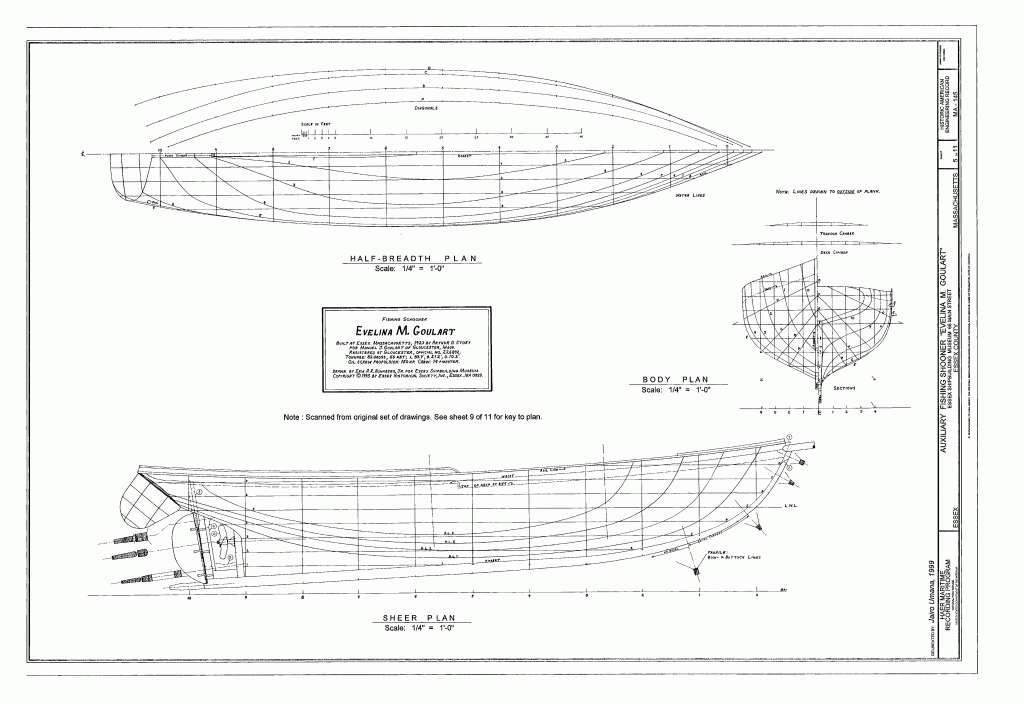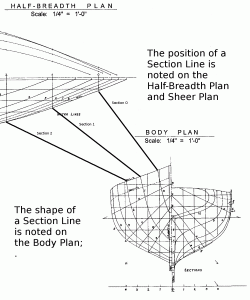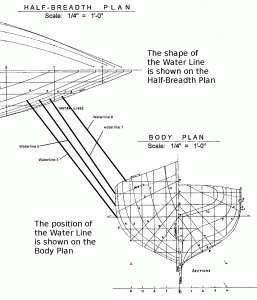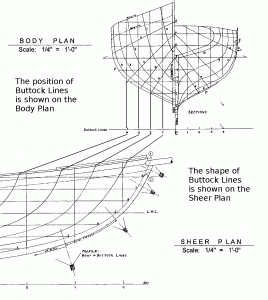What do all those lines on a ship plan mean?

The first time you see a ship plan, it looks like a spaghetti bowl of lines: some straight, some curved, some vertical, some horizontal, some diagonal, all crossing and recrossing each other in a tangle that can’t possibly be deciphered. You can make out the basic outline of a ship, but, what do all those lines mean?

The longer you look at it, the more the realize: There are three plans, each of which has a set of straight lines and a set of curved lines. On closer examination, you find that the curved lines on one plan have the same labels as the straight lines on another, and vice versa.
Hmmmmmm, a pattern is emerging …
To accurately depict the complex curves of a three-dimensional ship in a two-dimensional drawing, naval architects use a combination of lines: Section Lines, Water Lines, and Buttock Lines. These lines are shown in various combinations on three views of the ship: The Sheer Plan, the Section Plan, and the Half-Breadth Plan.
Imagine the hull as a loaf of bread. The Section Lines show the curves of the ship from the centerline in a vertical plane beam-wise, as if the ship was cut like slices of bread. The shape of their curve is shown on the Section Plan, while their position forward or aft on the keel is shown on the Sheer and Half-Breadth plans.

Slice that same loaf of bread lengthwise in horizontal slices, and you have the curves of the ship depicted by the Water Lines. Their shape is shown on the Half-Breadth plan, while their position above or below the Level Water Line is shown on the Section Plan.
Slice the loaf of bread lengthwide again, but this time in vertical slices, and you have the curves of the ship depicted by the Buttock Lines.The shape of the Buttock Lines is shown on the Sheer Plan, and their position relative to the ship’s centerline is noted on the Section Plan.
Note that the Section Plan only shows half of the shape of the hull, one side of the plan shows the sections from the bow aft to the mid-section, the other side shows the sections from the stern forward to the midsection. The curves are symmetrical, so both sides of the section need not be shown.

For the same reason, the Half-Breadth plan only shows half the shape of each waterline. Often the other half of this plan shows the arrangement of the ship’s deck.
The Sheer Plan also shows the top edge of the bulwarks (the sheer), and often shows the position of the deck(s). It also shows the rabbet line, where the ship’s planking meets the keel, stem and stern post.
These few lines on these three plans are all that are needed to build an accurate scale model of any ship. They also provide some shortcuts to modelers using the “bread & butter” method of hull construction, which we will discuss later.
The plans also usually feature the diagonal lines marked “D1,” “D2,” “D3” etc. used for calculating the Table of Offsets that mathematically describe the curves of the sections. The Table of Offsets offers a way to double check the draftsman’s work on the plan, but are of more use to the full-size ship builder than the model shipwright.
[…] sure to read our new page “How to Read a Ship Plan” that explains what the spaghetti-bowl of lines on a ship plan mean: This entry was posted […]
This is a wonderful sight , I kind of wish I could find the plans for barges such as the Edmond Fitzgerald
Did not think she was a Barge but a ship. Maybe I am wrong
Tenéis los planos de la goleta América de donde proviene el nombre de la copa América?
I will search my files. I believe I have a copy of the plan created by the French.
https://www.themodelshipwright.com/high-resolution-ship-plans/sailing-vessels/yacht-america/
Este es el plan de América en nuestro libro “Selected Plates from Souvenirs de Marine: Ship Plans by Vice-Admiral Francois-Edmond Paris” disponible en Amazon https://www.amazon.com/dp/1484921496
This plan of America is from our book “Selected Plates from Souvenirs de Marine: Ship Plans by Vice-Admiral Francois-Edmond Paris” available on Amazon https://www.amazon.com/dp/1484921496
[…] you’ve learned how to “read” a ship plan, it’s time to learn about the components that create the three-dimensional shape of a […]
[…] articles on How to Read a Ship Plan, and The Hull the Heart of a Ship will help you understand how the two-dimensional plan relates to […]
[…] articles on How to Read a Ship Plan, and The Hull the Heart of a Ship will help you understand how the two-dimensional plan relates […]
An excellent educational site. I would be very happy if you would also publish the plans of the dhow DHOW.
There are plans for a dhow on our page about bread-and-butter hull construction. If you left-click on the image of the plan it will open the full size image file. Right-click on that image, choose “save image as” and you can chose a site on your computer to which to download the file.
Lines of ship construction plans are explained in z clear and simple manner
.